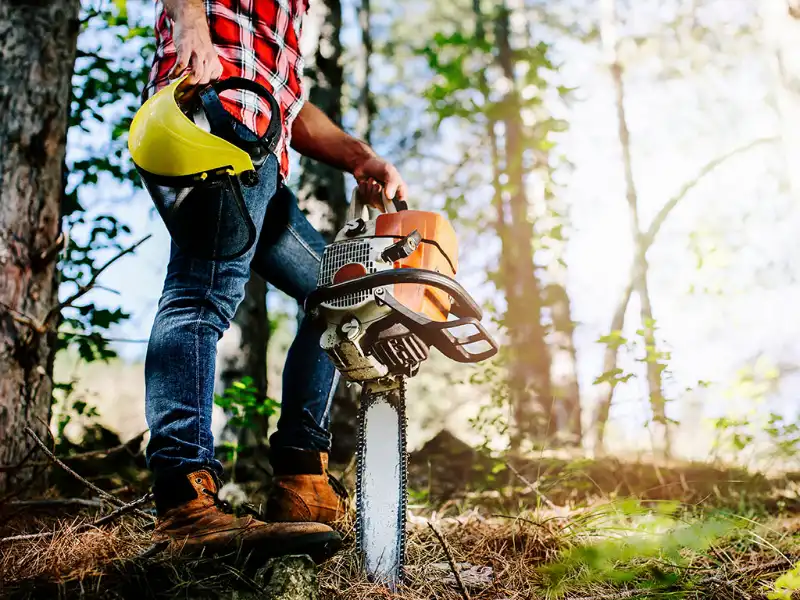Why do my trees need to be pruned?
There are quite a few reasons to have your trees pruned periodically. Here are just a few ways pruning helps trees stay healthy:
Minimizes the likelihood of limbs dropping naturally.
Some tree species are known to drop unhealthy limbs naturally. You can minimize the number of shed branches by periodically having weak or unruly branches pruned. By doing so, limbs that would cause stress to the tree in dry conditions are removed.
The trees most notorious for shedding limbs are gum trees, which are found throughout the United States. As far as we can tell, gum trees shed their limbs when they’re healthy but are under stress due to a lack of water. You can’t predict what limbs will drop when either. The tree seems to choose a random limb and will isolate it from the tree’s water supply. Isolating limbs helps the tree save water but will cause the branch to drop off eventually.
Prevents rot, decay, illness, and even tree death.
Pruning trees doesn’t necessarily act as an anti-cold vitamin, but pruning can prevent the spread of disease. Tree limbs with open wounds or gouges are a perfect entryway for bacteria, fungus, and other gross plant diseases.
If a tree is infected, a professional can prune the dead and infected branches to prevent the disease from spreading further. Doing so also encourages your tree to send resources to areas that will effectively fight the disease.
Avoid serious damage caused by windstorms.
By keeping your trees’ branches in good shape, you can minimize damage caused during a severe windstorm. Granted, you can’t completely avoid windstorm damage: there’re always news stories about windstorms knocking down entire trees. However, you can lower the chances of catastrophe with regular maintenance.
From minor dents to death…
Since our agency specializes in the outdoors, from campgrounds to hunting lodges, bed & breakfasts, and glamping resorts, we’ve seen many types of tree claims. In 2023 alone, we saw millions of dollars in claims.
Tree falling on guests: $1,037,095
Tree limb falling on guest: $1,036,274
Tree falling on guest: $1,016,487
Not only do trees fall on buildings, but they can also fall on your clients’ property. If a large limb falls on a brand new, 64-foot RV, the payout on the claim could be significant and take months to resolve.
On the other end of the spectrum, we’ve had clients report a death because of falling trees. During a bad storm, a tree on an adjacent property fell and landed on a tent with two campers inside. Both were tragically killed.
Needless to say, falling tree limbs don’t just impact you. They can cost you money, time, and even your reputation
What happens after filing a tree claim?
Filing the claim is only the first step. From there, your insurance carrier examines the details and uses case law to determine whether the claim was caused by ‘an act of god.’ The carrier also spends time to find who may be at fault.
In best-case scenarios, the matter will be settled. However, if attorneys get involved, the claims process can become far more expensive and take much longer than it would otherwise.
Keep in mind that even though insurance can help cover tree-related claims, it’s the business owner’s responsibility to avoid them as much as possible. If multiple claims are filed in a year, premiums may increase, and, in a worst-case scenario, the account could be considered too high-risk for the carrier and be dropped from the policy. The company would then have to find a new, more expensive carrier in a challenging insurance market.
No one wants to look for a new carrier, especially with multiple claims that could have been prevented.
How can I prevent filing tree-related claims?
The best way to prevent tree-related claims is to keep trees in good health. The best way to keep trees healthy is by hiring an arborist to regularly come in and give them the complete care they need.
Hiring an arborist might seem unnecessary but keep in mind that arborists are tree experts and know exactly how to keep them safe and in good shape. That said, please make sure your arborist has a certificate of insurance. This can be important information in litigation and will ensure that the arborist shares liability if there’s ever an unforeseen problem with a tree that the arborist should have known about.
Ultimately, trees on business property are the business owner’s responsibility. Regular maintenance is the way to go to keep trees happy and healthy year-round. Please give your arborist a call today and schedule a visit this winter.
Finally, don’t forget to document — reach out to me for your free tree maintenance plan.





